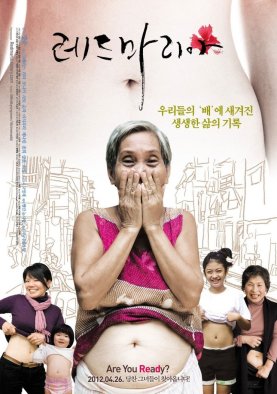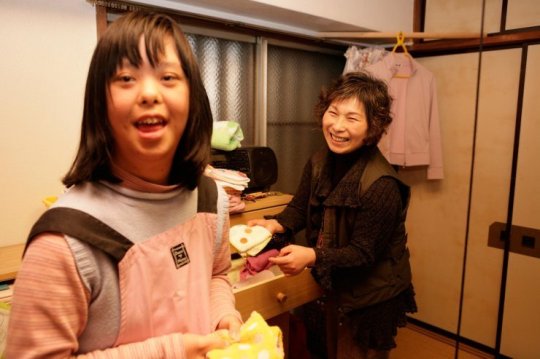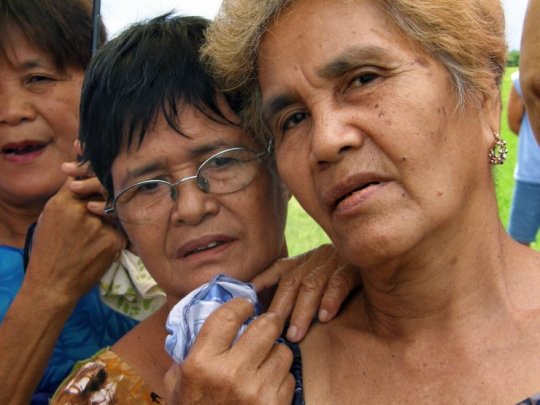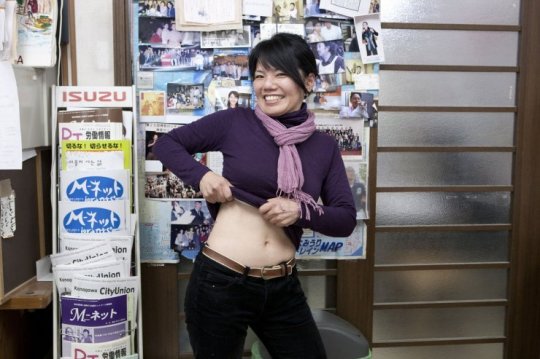“They are also laborers, and they have chosen it as their profession”
Red Maria talks about women and thus human beings through the body. It is a documentary with a macroscopic perspective, which also includes comfort women and sex workers.
Kyung-soon is now back in 4 years with
Red Maria 2, and this time she goes one step further. She asks a more concrete and fundamental question, juxtaposing gender, sex workers’ solidarity, and the current situation of Korean and Japanese sex workers, as well as the prostitutes said to have been among the comfort women.
Kyung-soon is a documentary filmmaker with 16 years of career and now further expanding her scope. Her debut was
Mindullae in 1999, and her filmography includes
Patriot Game,
Shocking Family and
Red Maria series, where she proves that filming a documentary is a process through which she finds her own identity, asking questions on politics, society, family and women’s issues.
Red Maria 2 is the only Korean film invited to the international competition section at the 7th edition of
DMZ International Documentary Film Festival (DMZ Docs), and won the Audience Award. When asked if the four year work was not too hard for her, she laughed whole heartedly, saying that it was quite the opposite, and that she took it light hearted instead.
It is a sequel to Red Maria (2012).
After I was done with Red Maria, what I wanted to do at first was a sequel to Patriot Game, depicting the right wing in Korea and Japan. But when I saw materials on sex workers and comfort women, I found myself more inclined to this subject matter. I felt I had no choice but to work on Red Maria 2. To be sure, Red Maria also deals with sex workers somewhat, but back then, it was not really possible to collect information on them. There were several obstacles including the special law against sex trade which resulted in severe police checking. When I was doing research after the release of Red Maria, I came across with a few people who made a coming out as sex workers, influenced by Red Maria. I also met Yeon-hee in the film thanks to Red Maria. And it was also helpful that the film was introduced in Japan.
The subject matter of Red Maria 2 is comfort women and sex workers, and so on. It seems like the scope and space have expanded and become more concrete, compared to Red Maria which focused on women’s issues.
I have also learned myself the history and origin of prostitution and sex labor. It’s pretty much the same with comfort women as well. In Korea and Japan, there have frequently been disputes whether to call them comfort women or prostitutes. That kind of dispute itself was very disturbing for me. Are comfort women that light? I started to re-examine the history of prostitution and the comfort women’s movement as a whole, starting from the question why this kind of issues had not been discussed in Korea.
This year is the 70th anniversary of national independence and thus the issue of comfort women has been often discussed between Korea and Japan.
News on comfort women are frequently delivered on media anyway, but that is pretty much it. You think you know, but you actually don’t. I was not much different either. I thought it was time to discuss the things that have been missed out from the existing discussion of comfort women movement and history. That is also why I went to Japan.
I am curious about your stay in Japan as well. How did it go?
Like my other films, my new film location has to do with my own journey pursuing a new interest of my own. What is interesting is that even among Japanese people, some were deeply touched by Red Maria. Yeon-hee introduced me to some Japanese sex workers and it turned out, they already knew Red Maria and they were happy to meet us. However, even for sex workers, comfort women were the kind of issue that they wanted to avoid. I had no choice but to explain everything one by one. It is a very sensitive issue, but at the same time, I have learned that more people than you expect sympathize with it. Of course it took quite a bit of time for us to interview people other than sex workers. It was the kind of issue that you can only talk once you have fully revealed yourself.
You dealt with a subject matter that is quite sensitive not just in Korea but also in the global world.
Prostitution is an occupation with a long history, dating a few thousand years, but it is barely recognized as labor. If you change the perspective, a lot of things will change too. It is totally different to call it sex labor rather than prostitution. There is the notion of self identity and basic human rights when you call it sex labor. After all, those engaged in this work have chosen this profession as a form of labor. It is weird to judge it right or wrong when they have chosen it themselves. If you really have sympathy for them, you should consider their environment, too. Either way, I am against the idea of elimination. You need to refuse the idea of elimination whether you are pro or against sex trade.
Are there any scenes you wish you could have done better?
A well known 70-year-old Taiwanese sex worker passed away. Taiwan has public brothels, and she did sex labor movement for more than 20 years there. She attempted at international solidarity of sex workers including with Korea, and Yeon-hee attended the funeral but I had to omit the footage because it was hard to explain the whole thing. The World Aids Meeting that I witnessed in Bangkok was very touching as well. So this is how they make solidarity with sex workers from Australia and Europe! They worked and talked like Korean labor movement activists. I thought we were very much backward (laughs). I felt as if I was looking at Korean labor movement activists in the past.
Did you have any difficulty working abroad?
In fact, it was actually easier. I didn’t have any pre-made bias against it, and I had no difficulty in meeting and interviewing local people. When I was making Red Maria, I went around with my staffs to meet local people and collect information, but this time I only took the minimum number of people with me and only when I really needed them, whether cameraman or interpreter. I gave up on my old style because explaining from a to z was already too much work for me. So working by myself throughout the whole thing was a big challenge for me, but when I actually made up my mind, it was not too bad. It was better in a way because I was free (laughs).
Did you have your own principles producing Red Maria 2?
In the past, I thought a lot about the eye level of audience. However, I am a filmmaker and auteur, an artist. I was not exactly happy trying to adjust to the eye level of the audience. This time I wanted to say what I really wanted to say without worrying about their eye level.
As a documentary filmmaker, it was not an easy subject matter to handle.
You make films because you want to, period. There is no such thing as an easy job. Life itself is hard. Besides, what was really hard for me was the sheer fact that you have to be brave and resolute to handle this subject matter even at this level. We really miss the questions like, what is the film, and what are the kind of things that have to be dealt with in films. Every art is a record and language. I struggle to fully realize that language in the film. So I made the film without worrying too much about distribution. Films have their own life paths. I don’t want to blame the situation, but I want to keep up my pride, and not get influenced by outside factors. I think it is a good attitude for independent filmmakers.
I hear it is a long way to go until release.
Color adjustment was made possible through
Korean Film Council (KOFIC)’s “2015 third quarter independent feature film post production goods support program”, by which my DMZ Docs submission was possible. Goods support was the first time for me, although
Red Maria’s distribution company
Cinema DAL got funding for diversity film section in 2012. As a matter of fact, I am still getting support. I have to work on the music again that I used for draft editing, and I also have to pay the sound fee. The debt is already several tens of thousand dollars (laughs). I am grateful for KOFIC and also for the DMZ Docs committee who invited the film to the international competition section. After the festival, I really wish I could have this film released even at one single theater.







